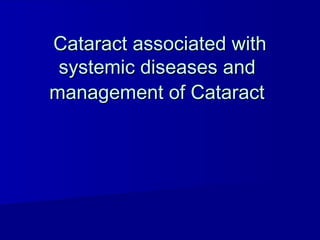
Management of cataract
- 1. Cataract associated with systemic diseases and management of Cataract
- 2. Complicated Cataract Cataract associated with ocular diseases: Complicated Cataract : is due to disturbance of the nutrition of lens due to inflammatory or degenerative disease of anterior and /or posterior segment of the eye like iridocyclitis, cilitis, pars planitis, choroiditis, myopic degeneration, retinitis pigmentosa, retinal detachment, other retinal pigmentory dystrophies etc.
- 3. Complicated Cataract Cataract has characteristic breadcrumb appearance and rainbow display of colours (polychromatic lustre). Vision is usually affected even in early stages as opacity is near the nodal point of the eye.
- 4. Complicated Cataract Prognosis depends on the causative condition. All cases of cataract without obvious cause should be carefully looked for keratic precipitates or evidences of pars planitis.
- 5. Cataract associated with systemic disease Diabetic Cataract: Early onset of senile cataract and cataract develops rapidly. True diabetic cataract is rare condition, occurring typically in young people with acute diabetes (with gross imbalance of water balance of the body). Fluid droplets (vacuoles) appear under the anterior and posterior subcapsular cortex, manifesting as myopia, producing diffuse opacity. These changes are reversible.
- 6. Diabetic Cataract The lens rapidly becomes cataractous with dense, white anterior and posterior subcapsular cortical cataract resembling snowstorm “snowflake Cataract”. If diabetes is controlled appropriately, the rapid progression to mature cataract may be arrested.
- 7. Cataract associated with systemic disease Parathyroid Tetany Myotonic Dystrophy Galactosaemia Down Syndrome Atopic Cataract
- 8. Objective Examination The state of the nucleus (grading of nuclear sclerosis) The state of the cortex The presence or absence of signs of inflammation Pupillary glow by transillumination B- Scan ultrasonography
- 9. Functional Tests Pupillary reaction Projection of light Macular function test – two pinholes test and Maddox rod test Entoptic view of the retina : Auto- ophthalmoscopy Electro-retinographic record, particularly of macula.
- 10. Pre-operative evaluation Thorough ocular examination to exclude any ocular disease like abnormalities of lids, lacrimal sac, conjunctiva (including conjunctival infections), cornea, uveal inflammation, glaucoma, posterior segment inflammatory/ degenerative condition etc.
- 11. Pre-operative evaluation Systemic examination to exclude hypertension, cardiovascular disorder, cerebro-vascular disease, chronic obstructive air way disorder etc. If any disorder is present, it should be adequately controlled before surgery ENT and Dental checkup to exclude septic focus
- 12. Treatment of cataract Medical treatment: No medical treatment is effective once the lens opacity has developed.
- 13. Treatment of cataract Surgical Treatment: Indication for surgery: 1. Cataract – when routine work becomes difficult due to reduced vision (attributable to cataract) 2. Subluxated or dislocated lens 3. Lens induced complications like phacolytic uveitis / glaucoma, phacoanaphylactic endophthalmitis, phacomorphic glaucoma.
- 14. Treatment of cataract Surgical Treatment: Options I. Intracapsular lens extraction (ICCE): Method of intracapsular cataract extraction (ICCE), now becoming obsolete, by which the entire lens including the capsule is removed by rupturing zonular ligaments.
- 15. Surgical Treatment of Cataract II. Extracapsular Cataract Extraction (ECCE): Methods – 1. Conventional ECCE 2. ECCE by small incision cataract surgery (SICS) 3. Lensectomy 4. Phacoemulsification
- 16. Steps of ECCE 1. Anaesthesia a. General Anaesthesia : In children, psychiatric patients, senile dementia b. Local anaesthesia: Retrobulbar block, peribulbar block, along with or without facial block , topical anaesthesia
- 17. Steps of ECCE 2. Cleaning of lids with 5% betadine solution and instillation of betadine solution in conjunctival sac 3. Draping 4. Superior Rectus suture in case of conventional ECCE and SICS 5. Conjunctival flap in case of SICS
- 18. Steps of ECCE 6. Scleral tunnel incision or Corneo-scleral section or corneal or corneal tunnel incision 7. Anterior chamber entry 8. Injection of ocular viscosurgical device (OVD) in anterior chamber (HPMC or Sodium Hyaluronate) 9. Capsulotomy ( can opener or continuous curvilinear capsulorrhexis, CCC)
- 19. Steps of ECCE 10. Hydrodissection and Hydrodelineation 11. Nucleus delivery (in conventional ECCE and SICS) / Phacoemulsification of nucleus (in phacoemulsification, machine , through titanium needle provides energy for emulsification of nucleus, needle vibrates at an speed of 20,000 Hz and pulverizes the nucleus)
- 20. Steps of ECCE 12. Cortical clean up by aspiration and irrigation (BSS or Ringer lactate is used as irrigating fluid) 13. Filling of lens capsule (capsular bag) with OVD 14. Insertion of posterior chamber IOL (in the bag, in case of complications in the ciliary sulcus)
- 21. Steps of ECCE 15. Removal of OVD from anterior chamber 16. Closure of wound of entry (corneoscleral wound requires sutures 10-0 silk or nylon), phaco and SICS incisions are self sealing.
- 22. Complications of Cataract Surgery I. Due to local anesthesia: Retrobulbar haemorrhage, globe perforataion, oculocardiac reflex etc. II. Intra-operative complications : detachment of descemet’s membrane, damage to corneal endothelium, zonular dialysis, posterior capsular rupture
- 23. Complications of cataract Surgery III. Early post-operative complications: wound leak and complications related to it (iris prolapse, flat anterior chamber), secondary glaucoma, postoperative infection, lens matter induced uveitis etc.
- 24. Complications of Cataract Surgery IV. Late post-operative complications: cystoid macular edema, posterior capsular opacification, corneal endothelial decompensation causing corneal edema, retinal detachment, displacement of IOL etc.
